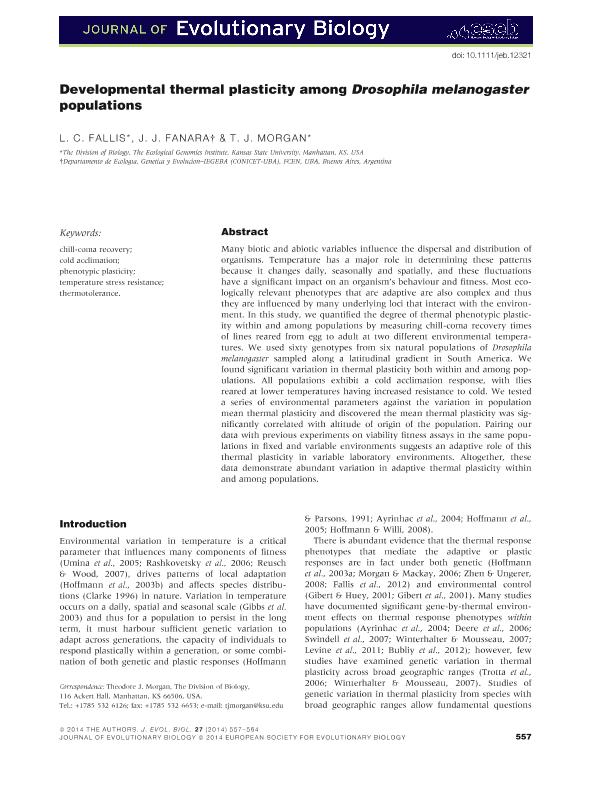Mostrar el registro sencillo del ítem
dc.contributor.author
Fallis, L. C.
dc.contributor.author
Fanara, Juan Jose

dc.contributor.author
Morgan, T. J.
dc.date.available
2017-07-06T17:28:44Z
dc.date.issued
2014-03
dc.identifier.citation
Fallis, L. C.; Fanara, Juan Jose; Morgan, T. J.; Developmental thermal plasticity among Drosophila melanogaster populations; Wiley; Journal Of Evolutionary Biology; 27; 3; 3-2014; 557-564
dc.identifier.issn
1010-061X
dc.identifier.uri
http://hdl.handle.net/11336/19739
dc.description.abstract
Many biotic and abiotic variables influence the dispersal and distribution of organisms. Temperature has a major role in determining these patterns because it changes daily, seasonally and spatially, and these fluctuations have a significant impact on an organism's behaviour and fitness. Most ecologically relevant phenotypes that are adaptive are also complex and thus they are influenced by many underlying loci that interact with the environment. In this study, we quantified the degree of thermal phenotypic plasticity within and among populations by measuring chill-coma recovery times of lines reared from egg to adult at two different environmental temperatures. We used sixty genotypes from six natural populations of Drosophila melanogaster sampled along a latitudinal gradient in South America. We found significant variation in thermal plasticity both within and among populations. All populations exhibit a cold acclimation response, with flies reared at lower temperatures having increased resistance to cold. We tested a series of environmental parameters against the variation in population mean thermal plasticity and discovered the mean thermal plasticity was significantly correlated with altitude of origin of the population. Pairing our data with previous experiments on viability fitness assays in the same populations in fixed and variable environments suggests an adaptive role of this thermal plasticity in variable laboratory environments. Altogether, these data demonstrate abundant variation in adaptive thermal plasticity within and among populations.
dc.format
application/pdf
dc.language.iso
eng
dc.publisher
Wiley

dc.rights
info:eu-repo/semantics/openAccess
dc.rights.uri
https://creativecommons.org/licenses/by-nc-sa/2.5/ar/
dc.subject
Phenotypic Plasticity
dc.subject
Chill-Coma Recovery
dc.subject
Thermotolerance
dc.subject
Adaptation
dc.subject.classification
Genética y Herencia

dc.subject.classification
Ciencias Biológicas

dc.subject.classification
CIENCIAS NATURALES Y EXACTAS

dc.title
Developmental thermal plasticity among Drosophila melanogaster populations
dc.type
info:eu-repo/semantics/article
dc.type
info:ar-repo/semantics/artículo
dc.type
info:eu-repo/semantics/publishedVersion
dc.date.updated
2017-07-05T15:02:22Z
dc.journal.volume
27
dc.journal.number
3
dc.journal.pagination
557-564
dc.journal.pais
Estados Unidos

dc.journal.ciudad
Hoboken
dc.description.fil
Fil: Fallis, L. C.. Kansas State University; Estados Unidos
dc.description.fil
Fil: Fanara, Juan Jose. Consejo Nacional de Investigaciones Científicas y Técnicas. Oficina de Coordinación Administrativa Ciudad Universitaria. Instituto de Ecología, Genética y Evolución de Buenos Aires. Universidad de Buenos Aires. Facultad de Ciencias Exactas y Naturales. Instituto de Ecología, Genética y Evolución de Buenos Aires; Argentina
dc.description.fil
Fil: Morgan, T. J.. Kansas State University; Estados Unidos
dc.journal.title
Journal Of Evolutionary Biology

dc.relation.alternativeid
info:eu-repo/semantics/altIdentifier/doi/http://dx.doi.org/10.1111/jeb.12321
dc.relation.alternativeid
info:eu-repo/semantics/altIdentifier/url/http://onlinelibrary.wiley.com/doi/10.1111/jeb.12321/abstract
Archivos asociados
